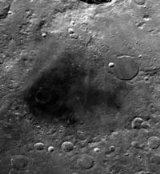
Mare Humboldtianum
Encyclopedia
Mare Humboldtianum is a lunar mare
located within the Humboldtianum basin, just to the east of Mare Frigoris
. It is located along the northeastern limb of the Moon
, and continues on to the far side. Due to its location, the visibility of this feature can be affected by libration
, and on occasion it can be hidden from view from Earth
.
The basin material is of the Nectarian
epoch
, with the mare material being of the Upper Imbrian
epoch. The lighter gray area to the southeast of the dark mare material is a region of hills within the basin. The rim of this basin forms a mountain range that can be seen under oblique lighting conditions.
The selenographic coordinates of this mare are 56.8° N, 81.5° E, and it has a diameter of 273 km. However the surrounding basin extends for a diameter of over 600 km. The walled plain Bel'kovich
spills over the northestern portion of Mare Humboldtianum, and the flooded crater Bel'kovich A lies across the southwestern rim of Bel'kovich and part of the floor of the mare.
This feature was named by Johann H. Mädler after Alexander von Humboldt, in recognition of his explorations of unknown lands. It is one of only two lunar maria that are named after people, the other being Mare Smythii
, and is located along the eastern lunar limb.
Lunar mare
The lunar maria are large, dark, basaltic plains on Earth's Moon, formed by ancient volcanic eruptions. They were dubbed maria, Latin for "seas", by early astronomers who mistook them for actual seas. They are less reflective than the "highlands" as a result of their iron-rich compositions, and...
located within the Humboldtianum basin, just to the east of Mare Frigoris
Mare Frigoris
Mare Frigoris is a lunar mare located just north of Mare Imbrium, and stretches east to north of Mare Serenitatis. The mare is in the outer rings of the Procellarum basin...
. It is located along the northeastern limb of the Moon
Moon
The Moon is Earth's only known natural satellite,There are a number of near-Earth asteroids including 3753 Cruithne that are co-orbital with Earth: their orbits bring them close to Earth for periods of time but then alter in the long term . These are quasi-satellites and not true moons. For more...
, and continues on to the far side. Due to its location, the visibility of this feature can be affected by libration
Libration
In astronomy, libration is an oscillating motion of orbiting bodies relative to each other, notably including the motion of the Moon relative to Earth, or of Trojan asteroids relative to planets.-Lunar libration:...
, and on occasion it can be hidden from view from Earth
Earth
Earth is the third planet from the Sun, and the densest and fifth-largest of the eight planets in the Solar System. It is also the largest of the Solar System's four terrestrial planets...
.
The basin material is of the Nectarian
Nectarian
The Nectarian Period of the lunar geologic timescale runs from 3920 million years ago to 3850 million years ago. It is the period during which the Nectaris Basin and other major basins were formed by large impact events...
epoch
Epoch (geology)
An epoch is a subdivision of the geologic timescale based on rock layering. In order, the higher subdivisions are periods, eras and eons. We are currently living in the Holocene epoch...
, with the mare material being of the Upper Imbrian
Upper Imbrian
In the Lunar geologic timescale, the Late Imbrian epoch occurred between 3800 million years ago to about 3200 million years ago. It was the epoch during which the mantle below the lunar basins partially melted and filled them with basalt...
epoch. The lighter gray area to the southeast of the dark mare material is a region of hills within the basin. The rim of this basin forms a mountain range that can be seen under oblique lighting conditions.
The selenographic coordinates of this mare are 56.8° N, 81.5° E, and it has a diameter of 273 km. However the surrounding basin extends for a diameter of over 600 km. The walled plain Bel'kovich
Bel'kovich (crater)
Bel'kovich is a large lunar crater of the form termed a walled plain. The formation has been heavily eroded by a history of subsequent impacts, leaving it reshaped, worn, and the features softened and rounded. Bel'kovich is located along the northeastern limb of the Moon, and so its visibility is...
spills over the northestern portion of Mare Humboldtianum, and the flooded crater Bel'kovich A lies across the southwestern rim of Bel'kovich and part of the floor of the mare.
This feature was named by Johann H. Mädler after Alexander von Humboldt, in recognition of his explorations of unknown lands. It is one of only two lunar maria that are named after people, the other being Mare Smythii
Mare Smythii
Mare Smythii is a lunar mare located along the equator on the easternmost edge of the lunar near side. The Smythii basin where the mare is located is of the Pre-Nectarian epoch, while the surrounding features are of the Nectarian system...
, and is located along the eastern lunar limb.

